Isle of Portland: Difference between revisions
| (One intermediate revision by one other user not shown) | |||
| Line 24: | Line 24: | ||
**[[Southwell, Dorset|Southwell]] | **[[Southwell, Dorset|Southwell]] | ||
**[[Wakeham]] | **[[Wakeham]] | ||
**[[The Grove, Dorset|The Grove]] | |||
Many old buildings are built out of Portland Stone; several parts have been designated Conservation Areas to preserve the unique character the older settlements which date back hundreds of years. The architecture; the natural and man-made environment and the proximity to the sea give Portland overall character which is quite distinct. | Many old buildings are built out of Portland Stone; several parts have been designated Conservation Areas to preserve the unique character the older settlements which date back hundreds of years. The architecture; the natural and man-made environment and the proximity to the sea give Portland overall character which is quite distinct. | ||
| Line 50: | Line 51: | ||
Early helicopters were stationed at Portland in 1946-1948, and in 1959 a shallow tidal flat, The Mere, was infilled, and sports fields taken to form a heliport. The station was formally commissioned as HMS Osprey, which then became the largest and busiest military helicopter station in Europe. The base was gradually improved with additional landing areas and one of Britain's shortest runways, at 751 feet.<ref name="serepta" /> | Early helicopters were stationed at Portland in 1946-1948, and in 1959 a shallow tidal flat, The Mere, was infilled, and sports fields taken to form a heliport. The station was formally commissioned as HMS Osprey, which then became the largest and busiest military helicopter station in Europe. The base was gradually improved with additional landing areas and one of Britain's shortest runways, at 751 feet.<ref name="serepta" /> | ||
The naval base closed after the end of the Cold War in 1995, and the Royal Naval Air Station closed in 1999, although the runway remained in use for Her Majesty's Coastguard Search and Rescue flights as MRCC Portland.<ref name="serepta" /> MRCC Portland's area of responsibility extends midway across the [[English Channel]], and from [[Start Point]] in [[Devon]] to the Dorset/[[Hampshire]] border. The 12 Search and Rescue teams in the Portland area dealt with almost 1000 incidents in 2005;<ref name="mrccportland">{{cite web | year=2007 | url=http://www.mcga.gov.uk/c4mca/mcga-dops-regional/eastern-region/mcga-dops_rr_east_regional-eastern-region-solent.htm | title=Eastern Region — Area South | publisher=[[Maritime and Coastguard Agency]] | accessdate=2007-07-28}}</ref> | The naval base closed after the end of the Cold War in 1995, and the Royal Naval Air Station closed in 1999, although the runway remained in use for Her Majesty's Coastguard Search and Rescue flights as MRCC Portland.<ref name="serepta" /> MRCC Portland's area of responsibility extends midway across the [[English Channel]], and from [[Start Point, Devon|Start Point]] in [[Devon]] to the Dorset/[[Hampshire]] border. The 12 Search and Rescue teams in the Portland area dealt with almost 1000 incidents in 2005;<ref name="mrccportland">{{cite web | year=2007 | url=http://www.mcga.gov.uk/c4mca/mcga-dops-regional/eastern-region/mcga-dops_rr_east_regional-eastern-region-solent.htm | title=Eastern Region — Area South | publisher=[[Maritime and Coastguard Agency]] | accessdate=2007-07-28}}</ref> | ||
===Prisons=== | ===Prisons=== | ||
Latest revision as of 15:34, 28 February 2021
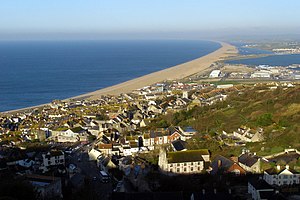
The Isle of Portland is a limestone tied island on the Dorset coast. It is 4 miles long by a mile and a half wide, projecting into the the English Channel and joined to mainland Great Britain by a narrow strip of land which extends 18 miles parallel to the coast as Chesil Beach and by a short causeway to Wyke Regis over which runs the A354 road.
Portland is 5 miles south of the town of Weymouth at SY690721 and forms the southernmost point of the county. The population of the Isle is almost 13,000.
Portland is a central part of the Jurassic Coast, a World Heritage Site on the Dorset and east Devon coast, important for its geology and landforms. Its name is used for one of the British Sea Areas. Portland stone, famous for its use in British and world architecture, including St Paul's Cathedral, continues to be quarried.
Portland Harbour, in the bay between Portland and Weymouth, is one of the largest man-made harbours in the world. The harbour was formed by the building of stone breakwaters between 1848 and 1905. From its inception it was a Royal Navy base, and played prominent roles during the First and Second World Wars; ships of the Royal Navy and NATO countries worked up and exercised in its waters until 1995. The harbour is now a civilian port and popular recreation area. It was used for sailing events at the 2012 Olympic Games.
Geography
The Isle of Portland lies in the English Channel, 2 miles south of Wyke Regis. It is approximately half-way along the UNESCO-listed "Jurassic Coast" World Heritage Site. The South West Coast Path runs around the coast; it is the United Kingdom's longest "national trail" at 630 miles. Portland is connected to the mainland at Abbotsbury by Chesil Beach, which runs 18 miles northwest to West Bay.[1] A causeway joins Portland to the mainland at Wyke Regis.
Villages


There are eight villages on Portland:
- On Underhill -
- Fortuneswell, the largest village of the Isle;
- Castletown
- Chiswell
- On Tophill:
Many old buildings are built out of Portland Stone; several parts have been designated Conservation Areas to preserve the unique character the older settlements which date back hundreds of years. The architecture; the natural and man-made environment and the proximity to the sea give Portland overall character which is quite distinct.
History

Portland has been inhabited since at least the Middle Stone Age; there is archaeological evidence of Mesolithic inhabitants near Portland Bill,[2] and of inhabitation in ages since. The Romans occupied Portland, reputedly calling it Vindelis.[3][4]
Portland is an ancient Royal Manor, and until the 19th century remained a separate liberty within Dorset for administration purposes.
In 1539, King Henry VIII ordered the construction of Portland Castle for defence against attacks by the French; the castle cost £4,964.[5] It is one of the best preserved castles from this period, and is open to the public by the custodians English Heritage.[6]
Sir Christopher Wren, the architect and Member of Parliament for nearby Weymouth, used six million tons of white Portland limestone to rebuild destroyed parts of London after the Great Fire of London of 1666. Well-known buildings in the capital, including St Paul's Cathedral and the eastern front of Buckingham Palace feature the stone.[7]
After the First World War, a quarry was opened by The Crown Estate to provide stone for the Cenotaph in Whitehall and half a million gravestones for war cemeteries,[4] and after the Second World War hundreds of thousands of gravestones were hewn for the fallen soldiers on the Western Front.[4] (Portland cement has nothing to do with Portland; it was named such due to its similar colour to Portland stone when mixed with lime and sand.)[8]
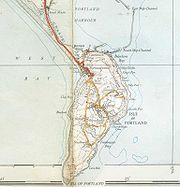
There have been railways in Portland since the early 19th century. The Merchant's Railway was the earliest; it opened in 1826, just one year after the Stockton and Darlington railway. The Merchant's Railway ran from the quarries at the north of Tophill to a pier at Castletown, from where the Portland stone was shipped around the country.[9] The Weymouth and Portland Railway was laid in 1865, and ran from a station in Melcombe Regis, across the Fleet and along the low isthmus behind Chesil Beach to a station at Victoria Square in Chiswell.[10] At the end of the 19th century the line was extended to the top of the island as the Easton and Church Hope Railway, running through Castletown and ascending the cliffs at East Weares, to loop back north to a station in Easton.[9] The line closed to passengers in 1952, and the final goods train (and two passenger 'specials') ran in April 1965.[10]
The Royal National Institution for the Preservation of Life from Shipwreck (now the RNLI) stationed a lifeboat at Portland in 1826, which was withdrawn in 1851.[11]
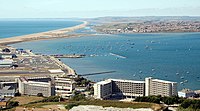
At the start of the First World War, HMS Hood was sunk in the passage between the southern breakwaters to protect the harbour from torpedo and submarine attack.[12] Portland Harbour was formed (1848–1905) by the construction of breakwaters, but before that the natural anchorage had hosted ships of the Royal Navy for more than 500 years. It was a centre for Admiralty research into asdic submarine detection and underwater weapons from 1917 to 1998; the shore base HMS Serepta was renamed HMS Osprey in 1927.[13] During the Second World War Portland was the target of heavy bombing, although most warships had moved north as Portland was within enemy striking range across the Channel. Portland was a major embarkation point for Allied forces on D-Day in 1944.
Early helicopters were stationed at Portland in 1946-1948, and in 1959 a shallow tidal flat, The Mere, was infilled, and sports fields taken to form a heliport. The station was formally commissioned as HMS Osprey, which then became the largest and busiest military helicopter station in Europe. The base was gradually improved with additional landing areas and one of Britain's shortest runways, at 751 feet.[13]
The naval base closed after the end of the Cold War in 1995, and the Royal Naval Air Station closed in 1999, although the runway remained in use for Her Majesty's Coastguard Search and Rescue flights as MRCC Portland.[13] MRCC Portland's area of responsibility extends midway across the English Channel, and from Start Point in Devon to the Dorset/Hampshire border. The 12 Search and Rescue teams in the Portland area dealt with almost 1000 incidents in 2005;[14]
Prisons
There are still two prisons on Portland, HMP The Verne, which until 1949 was a huge Victorian military fortress, and a Young Offenders' Institution on the Grove clifftop. This was the original prison built for convicts who quarried stone for the Portland Breakwaters from 1848. For a few years until 2005 Britain's only prison ship, HMP The Weare, was berthed in the harbour.
Flooding
Coastal flooding has affected Portland's residents and transport for centuries; the only way off the island is along the causeway in the lee of Chesil Beach. At times of extreme floods (about every 10 years) this road link is cut by floods. The low-lying village of Chiswell used to flood on average every 5 years. Chesil Beach occasionally faces severe storms and massive waves, which have a fetch across the Atlantic Ocean.[15] Following two severe flood events in the 1970s, the council and Wessex Water decided to investigate the structure of the beach, and possible coastal management schemes that could be built to protect Chiswell and the beach road. In the 1980s it was agreed that a scheme to protect against a one-in-five year storm would be practicable; it would reduce flood depth and duration in more severe storms.[15] Hard engineering techniques were employed in the scheme, including a gabion beach crest running a mile to the north of Chiswell, an extended sea wall in Chesil Cove, and a culvert running from inside the beach, underneath the beach road and into Portland Harbour, to divert flood water away from low lying areas.[15]
Geology
Geologically, Portland is separated into two areas; the steeply sloping land at its north end called Underhill, and the larger, gently sloping land to the south, called Tophill. Portland stone lies under Tophill; the strata decline at a shallow angle of around 1½ degrees, from a height of 500 feet near the Verne in the north, to just above sea level at Portland Bill.[16]
The geology of Underhill is different from Tophill's; Underhill lies on a steep escarpment composed of Portland Sand, lying above a thicker layer of Kimmeridge Clay, which extends to Chesil Beach and Portland Harbour. This Kimmeridge Clay has resulted in a series of landslides, forming West Weares and East Weares.[16]
A mile and a half beneath south Dorset lies a layer of Triassic rock salt, and Portland is one of four locations in the United Kingdom where the salt is thick enough to create stable cavities.[17][18] Portland Gas has applied to excavate 14 caverns to store vast amounts of natural gas, for up to 1% of the United Kingdom’s total annual demand.[17][18] The caverns will be connected to the National gas grid at Mappowder by way of a 23-mile pipeline.[17][18]
Features
Portland Bill
- Main article: Portland Bill
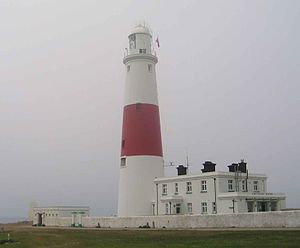
Portland Bill is the southern tip of the island of Portland. The Bill has three lighthouse towers: The Higher Lighthouse is now a dwelling and holiday apartments; the Lower Lighthouse is now a bird observatory and field centre which opened in 1961. The white and red lighthouse on Bill Point replaced the Higher and Lower Lighthouses in 1906. It is a prominent and much photographed feature; an important landmark for ships passing the headland and its tidal race.
The current lighthouse was refurbished in 1996 and became remotely controlled. It now contains a visitors' centre giving information and guided tours of the lighthouse.[19] As of June 2009, the lighthouse uses a 1 kW metal-halide lamp with an operational life of about 4000 hours, or 14 months. Two earlier lighthouses stand further inland: one is an important observatory used by ornithologists, providing records of bird migration and accommodation for visitors.[19]
Portland Ledge
Portland Ledge (the Shambles) is an underwater extension of Portland Stone into the English Channel at a place where the depth of Channel is about 10 to 20 fathoms. Tidal flow is disrupted by the feature; at 5 fathoms deep and a mile and a half long, it causes a tidal race to the south of Portland Bill, the so-called Portland Race.[20] The current only stops for brief periods during the 12½ hour tidal cycle and can reach 4 ms-1 at the spring tide.[20]
Ecology
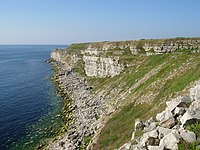
Due to its isolated coastal location, the Isle of Portland has an extensive range of flora and fauna; the coastline and disused quarries are designated as Sites of Special Scientific Interest. Sea and migratory birds occupy the cliffs in different seasons, sometimes these include rare species which draw ornithologists from around the country.[21] Rare visitors to the surrounding seas include dolphins, seals and basking sharks. Chesil Beach is one of only two sites in Britain where the Scaly Cricket can be found; unlike any other cricket it is wingless and does not sing or hop.[21] Ten British Primitive goats were introduced to the East Weares part of the island to control scrub in 2007.[22]
The comparatively warm and sunny climate allows species of plants to thrive which do not on the mainland. The limestone soil has low nutrient levels; hence smaller species of wild flowers and grasses are able to grow in the absence of larger species. Portland Sea Lavender can be found on the higher sea cliffs—unique to Portland it is one of the United Kingdom's rarest plants.[23] The wild flowers and plants make an excellent habitat for butterflies; over half of the British Isles' 57 butterfly species can be seen on Portland, including varieties that migrate from mainland Europe. Species live on Portland that are rare in the United Kingdom, including the limestone race of the Silver Studded Blue.[24]
Culture
Sport and recreation
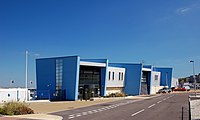
In 2000, the Weymouth and Portland National Sailing Academy was built in Osprey Quay in Underhill as a centre for sailing in the United Kingdom. Weymouth Bay|Weymouth and Portland's waters were credited by the Royal Yachting Association as the best in Northern Europe.[25] Weymouth and Portland regularly host local, national and international sailing events in their waters; these include the J/24 World Championships in 2005, trials for the 2004 Athens Olympics, the ISAF World Championship 2006, the BUSA Fleet Racing Championships, and the RYA Youth National Championships.[26]
In 2005, the WPNSA was selected to host sailing events at the 2012 Olympic Games, in part because the Academy had recently been built, so no new venue would have to be provided,[27] , though also the seas of Wemouth are internationally renowned as idea sailing conditions for racing events. In the event, Osprey Quay, a new 600-berth marina and an extension with more on-site facilities was built. With a formal opening on 11 June 2009, the Olympic venue became the first of the 2012 Olympic Games to be completed.[28][29][30][31]
Weymouth Bay and Portland Harbour are used for other water sports — the reliable wind is favourable for windsurfing and kitesurfing. Chesil Beach and Portland Harbour are used regularly for angling, diving to shipwrecks, snorkelling, canoeing, and swimming. The limestone cliffs and quarries are used for rock climbing; Portland has areas for bouldering and deep water soloing, however sport climbing with bolt protection is the most common style.[32] Since June 2003 the South West Coast Path National Trail has included coastal walking around the Isle of Portland.
- Football: Portland United FC
Rabbits
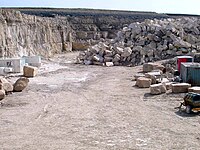
Rabbits have long been associated with bad luck on Portland and use of the name is still taboo; the creatures are often referred to as "Underground Mutton", "Long-Eared Furry Things" or just "bunnies".[33] The origin of this superstition is obscure (there is no record of it before the 1920s) but it is believed to derive from quarry workers; they would see rabbits emerging from their burrows immediately before a rock fall and blame them for increasing the risk of dangerous, sometimes deadly, landslides.[34] If a rabbit was seen in a quarry, the workers would pack up and go home for the day, until the safety of the area had been assured.[33] Local fishermen too would refuse to go to sea if the word was mentioned.
Even today older Portland residents are 'offended' (sometimes for the benefit of tourists) at the mention of rabbits;[34] this superstition came to national attention in October 2005 when a special batch of advertisement posters were made for the Wallace and Gromit film, The Curse of the Were-Rabbit. In respect of local beliefs the adverts omitted the word 'rabbit' and replaced the film's title with the phrase "Something bunny is going on".[33]
Literature
Thomas Hardy called Portland the Isle of Slingers in his novels; the isle was the main setting of The Well-Beloved (1897), and was featured in The Trumpet-Major (1880).[35] The cottage that now houses Portland Museum was the inspiration for the heroine's house in The Well-Beloved. Portlanders were expert stone-throwers in the defence of their land, and Hardy's Isle of Slingers is heavily based on Portland; the Street of Wells representing Fortuneswell and The Beal Portland Bill. Hardy named Portland the Gibraltar of the North, with reference to its similarities with Gibraltar; its physical geography, isolation, comparatively mild climate, and Underhill's winding streets.[36]
In The Warlord Chronicles (1995-97), Bernard Cornwell makes Portland the Isle of the Dead, a place of internal exile, where the causeway was guarded to keep the 'dead' (people suffering insanity) from crossing the Fleet and returning to the mainland. No historical evidence exists to support this idea.[37]
The Portland Chronicles series of four children's books, set on and around Portland and Weymouth and written by local author Carol Hunt, draw on local history to explore a seventeenth century world of smuggling, witchcraft, piracy and local intrigue.[38]
Dialect
- Bunnies: Rabbits (see above).
- Kimberlin': slang for any 'strangers' not from the Island.[39]
- Portland screw: fossil mollusc (Aptyxiella portlandica) with a long screw-like shell or its cast.[40]
Outside links
| ("Wikimedia Commons" has material about Isle of Portland) |
- Geology of the Wessex Coast of Southern England
- Exploring Portland
- Portland's very own 'Royal Manor Theatre'
- Portland Sculpture & Quarry Trust
- Isle of Portland Industrial Archaeological Survey from English Heritage
References and notes
- ↑ "The Chesil Beach — General Introduction". Southampton University. 2007. http://www.soton.ac.uk/~imw/chesil.htm. Retrieved 2007-08-13.
- ↑ "Mesolithic Site, Portland". Association for Portland Archaeology. 2002. Archived from the original on 2007-06-09. http://web.archive.org/web/20070609212653/http://www.gallica.co.uk/celts/portland.htm. Retrieved 2007-07-30.
- ↑ "Lexicon Universale". Universität Mannheim. 2006. http://www.uni-mannheim.de/mateo/camenaref/hofmann/hof4/s0773b.html. Retrieved 2007-04-03.
- ↑ 4.0 4.1 4.2 "Portland—Dorset". Dorset Guide. 2007. http://www.dorsets.co.uk/Portland/. Retrieved 2007-04-03.
- ↑ "Portland, Dorset, England". The Dorset Page. 2000. http://www.thedorsetpage.com/locations/Place/P120.htm. Retrieved 2007-07-26.
- ↑ "Portland Castle". English Heritage. 2007. http://www.english-heritage.org.uk/server/show/nav.15746. Retrieved 2007-07-30.
- ↑ "Buckingham Palace History". HM Queen Elizabeth II. 2007. http://www.royal.gov.uk/output/Page568.asp. Retrieved 2007-04-03.
- ↑ "History & Manufacture of Portland Cement". Portland Cement Association. 2007. http://www.cement.org/basics/concretebasics_history.asp. Retrieved 2007-07-26.
- ↑ 9.0 9.1 "Railways of the Weymouth area". Island Publishing. 2005. http://www.johnrnew.demon.co.uk/weyrails.htm. Retrieved 2007-07-26.
- ↑ 10.0 10.1 "Weymouth to Portland Railway, Construction and growth". Weymouth and Portland Borough Council. 2007. Archived from the original on October 8, 2007. http://web.archive.org/web/20071008013056/http://www.weymouth.gov.uk/main.asp?svid=351. Retrieved 2007-07-26.
- ↑ Denton, Tony (2009). Handbook 2009. Shrewsbury: Lifeboat Enthusiasts Society. p. 59.
- ↑ "Turret Battleship, HMS Hood". Cranston Fine Arts. 2007. http://www.battleships-cruisers.co.uk/hms_hood.htm. Retrieved 2007-07-26.
- ↑ 13.0 13.1 13.2 "Portland Base/Heliport History". helis.com. 2007. http://www.helis.com/database/?menu=2&tpais=UK&tbase=33&menudiv=1. Retrieved 2007-07-28.
- ↑ "Eastern Region — Area South". Maritime and Coastguard Agency. 2007. http://www.mcga.gov.uk/c4mca/mcga-dops-regional/eastern-region/mcga-dops_rr_east_regional-eastern-region-solent.htm. Retrieved 2007-07-28.
- ↑ 15.0 15.1 15.2 "Chiswell case study: The Scheme". Jurassic Coast. 2007. http://www.swgfl.org.uk/jurassic/chis10.htm. Retrieved 2007-07-27.
- ↑ 16.0 16.1 "General Geology". Southampton University. 2007. http://www.soton.ac.uk/~imw/portnew.htm#cross. Retrieved 2007-07-26.
- ↑ 17.0 17.1 17.2 "Island may be key gas supplier". Dorset Echo. 2007. http://www.dorsetecho.co.uk/news/local/display.var.1881457.0.island_may_be_key_gas_supplier.php. Retrieved 2007-12-05.
- ↑ 18.0 18.1 18.2 "Portland gas storage project". Portland Gas. 2007. http://www.portland-gas.com/index.php?option=com_content&task=view&id=48&Itemid=105. Retrieved 2007-12-05.
- ↑ 19.0 19.1 "Portland Bill Lighthouse". Trinity House. 2007. http://www.trinityhouse.co.uk/interactive/gallery/portland_bill.html. Retrieved 2007-07-26.
- ↑ 20.0 20.1 "Offshore Geology". Southampton University. 2007. http://www.soton.ac.uk/~imw/portnew.htm#offshore. Retrieved 2007-07-26.
- ↑ 21.0 21.1 "Chesil Beach". Weymouth and Portland Borough Council. 2007. Archived from the original on May 13, 2007. http://web.archive.org/web/20070513190720/http://www.weymouth.gov.uk/main.asp?svid=542. Retrieved 2007-07-27.
- ↑ "Wildlife on Portland" (pdf). Heights Hotel and Swarovski Optik. Spring 2008. http://www.portlandcp.org.uk/island/WildlifeNewsletter.pdf. Retrieved 18 March 2012.
- ↑ "Coastal Flora & Fauna". Weymouth and Portland Borough Council. 2007. Archived from the original on May 13, 2007. http://web.archive.org/web/20070513164925/http://www.weymouth.gov.uk/main.asp?svid=543. Retrieved 2007-07-27.
- ↑ "Portland Butterflies". Weymouth and Portland Borough Council. 2007. Archived from the original on May 13, 2007. http://web.archive.org/web/20070513190734/http://www.weymouth.gov.uk/main.asp?svid=541. Retrieved 2007-07-27.
- ↑ "2012 Olympic Games sailing venue". Weymouth and Portland Borough Council. 2005. Archived from the original on December 31, 2006. http://web.archive.org/web/20061231110947/http://www.weymouth.gov.uk/London2012/home.asp?svid=14. Retrieved 2006-11-12.
- ↑ "WPNSA — press releases". Weymouth and Portland National Sailing Academy. 2006. Archived from the original on December 2, 2006. http://web.archive.org/web/20061202013033/http://www.wpnsa.org.uk/pressreleases.htm. Retrieved 2006-11-12.
- ↑ "Sailing town's joy at Olympic win". BBC. 2005-07-06. http://news.bbc.co.uk/1/hi/england/dorset/4653721.stm. Retrieved 2008-01-07.
- ↑ "New Olympic marina plan approved". The BBC. 2007-06-27. http://news.bbc.co.uk/1/hi/england/dorset/6246176.stm. Retrieved 2007-06-27.
- ↑ "2012 work completed at WPNSA". Royal Yachting Association. 2009. http://www.rya.org.uk/newsevents/news/Pages/2012sailingvenueofficially.aspx. Retrieved 2009-08-10.
- ↑ "Sailing rivals use Olympic venue". BBC News. 2009-08-10. http://news.bbc.co.uk/1/hi/england/dorset/8193246.stm. Retrieved 2009-08-10.
- ↑ "First 2012 Olympic venue unveiled". BBC News. 2008-11-28. http://news.bbc.co.uk/1/hi/england/dorset/7753734.stm. Retrieved 2009-09-30.
- ↑ "World Rock Climbing Information: Portland". Rockfax. 2007. http://www.rockfax.com/databases/results_area.html?id=5. Retrieved 2007-05-19.
- ↑ 33.0 33.1 33.2 "Wallace and Gromit spook island". BBC. 2005-10-07. http://news.bbc.co.uk/1/hi/england/dorset/4318710.stm. Retrieved 2007-07-26.
- ↑ 34.0 34.1 "Rabbits, the Portland taboo word". Weymouth and Portland Borough Council. 2006. Archived from the original on October 24, 2007. http://web.archive.org/web/20071024070726/http://www.weymouth.gov.uk/main.asp?svid=784. Retrieved 2007-07-26.
- ↑ "Thomas Hardy County and the Hardy Trail". Lyme Regis Tourist Information. 2007. http://www.lymeregis.com/hardy_country/. Retrieved 2007-07-26.
- ↑ "The Well-Beloved by Thomas Hardy". Full Books. 2007. http://www.fullbooks.com/The-Well-Beloved1.html. Retrieved 2007-07-26.
- ↑ "The Isle of the Dead". British Society of Dowsers. 1999. http://www.britishdowsers.org/EEG_site/archive/articles/aua2001_issue24/isleofdead_JHarvey_m.htm. Retrieved 2007-07-30.
- ↑ http://www.rovingpress.co.uk/PortlandSeaDragon.html
- ↑ Fido Lunettes (nom de plume), 1825, An Historical and Descriptive Account of the Peninsula of Portland from the Earliest to the Present Time, p48 summary in The Portland Year Book and Island Record 1905, reprinted Portland Museum, 2004
- ↑ "The Independent Quarry Research Project". Portland Quarry and Sculpture Trust. 2000. http://iq.learningstone.net/p2/nf/bob_ford/briefing_pack/portland_stone.php. Retrieved 2010-07-21.
Books
- Anon 1905, The Portland Year Book and Island Record 1905, reprinted 2004, Portland Museum, Portland, Dorset
- Stuart Morris, 1985 Portland, an Illustrated History The Dovecote Press, Wimborne, Dorset: ISBN 0-946159-34-3
- Stuart Morris, 1998 Portland (Discover Dorset Series) The Dovecote Press, Wimborne, Dorset: ISBN 1-874336-49-0.
- Jackson, Brian L. 1999. Isle of Portland railways. ISBN 0-85361-540-3
- Palmer, Susann. 1999. Ancient Portland: Archaeology of the Isle. Portland: S. Palmer. ISBN 0-9532811-0-8
- Stuart Morris, 2002 Portland: A Portrait in Colour The Dovecote Press, Wimborne, Dorset: ISBN 1-874336-91-1.
- Stuart Morris, 2006 Portland, Then and Now The Dovecote Press, Wimborne, Dorset: ISBN 1-904349-48-X.
